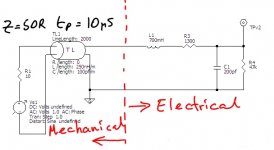Finally some data! I love that discussion by Kelly in Gramophone.
Unfortunately gramophone.net appears to be gone.
Unfortunately gramophone.net appears to be gone.
A new domain?
gramophone.co.uk | The world's authority on classical music since 1923
Last edited:
but you have to subscribe these days to get access to all the back issues. Given the size of the archive it is worthwhile if you are a music lover though.
Can't find the link but apparently their music archive is something we would all like to have access to.
A little too much for casual reading a few back issues.
Yes.This seems to agree with the above ~40 mechanical Ohms in the critical band. Is that right?
As you point out, Stanley Kelly's quote has pretty much nailed it:
"This dissertation is to illustrate the difficulties in assessing the euphemistic quality known as 'stylus mass' or 'equivalent mass referred to stylus tip'. Because there are inevitably a number of resonances in the upper frequency regions, it is not possible, except in very simple structures, to give one value for tip mass which is meaningful! But what is important is the impedance presented to the record. "
Incidentally, the plot for mechanical impedance of the DL-103 illustrates the method used by many Japanese cartridge manufacturers to specify dynamic compliance at 100Hz.
From the plot, we can read impedance at 100Hz as c 450 dyne s/cm. Were this impedance to be provided by a simple spring, that spring would have a compliance of:
1 / ( 20.5 * pi * 100Hz * 450 dyne s cm-1) = 5 x 10-6 cm dyne-1
......which is spot on Denon's published figure 5 x 10-6 cm dyne-1
In case you ever wondered how compliance at 100Hz is obtained, that is the answer. HOWEVER, in practice impedance of the cartridge suspension at 100Hz is not a pure spring, there is significant damping contribution which varies from manufacturer to manufacturer and cartridge to cartridge. This is why it is so difficult to convert between spec compliance at 100Hz from mostly Japanese manufacturers and spec compliance at 10Hz from ROW - at 10Hz impedance is mostly pure spring and at 100Hz it isn't.
Lucky
Thank you for these informative posts.
I'll come to the issue another day.
For now as a small pay back, here is a Shure catalog from 1976 with trackability curves of many of it's cartridges
https://shure.custhelp.com/ci/fattach/get/28017/0/filename/1976+Phonograph.pdf
George
Thank you for these informative posts.
I'll come to the issue another day.
For now as a small pay back, here is a Shure catalog from 1976 with trackability curves of many of it's cartridges
https://shure.custhelp.com/ci/fattach/get/28017/0/filename/1976+Phonograph.pdf
George
Last edited:
....geeez...phono carts... what'll they think of next?
Gitten out of Kathmandu asap.... read in paper this morning that Cholera is spreading in the city.....
-RNM
Not too long ago in some parts of Europe virtually all liquid folks drank had alcohol added to it to prevent such diseases. Grog of course was half rum and half water. That is where the word groggy comes from. The daily rum ration was of course considered essential.
Poorer folks had to settle for boiling water before drinking it.
The real kicker is that if you get it, the treatment is lots of water... and if the water is what gave it to you, then things get worse quite quickly.
There is a vaccine for it, easy to take but only lasts a few months.
So here is hoping you only wake up stiff and sore each day!
Poorer folks had to settle for boiling water before drinking it.
Or beer, or Gin.
I do find it fascinating how the mutation to protect against bubonic plague (and to an extent HIV causing AIDS) was the same one that allows us to process alcohol. One theory is that the black death wiped out all the lightweights leaving europe full of drinkers. I like this theory so am sticking to it
A little too much for casual reading a few back issues.
I will see if I can get access to some of the interesting stuff by other means.
Bottled drinking water ?....geeez...phono carts... what'll they think of next?
Unfortunately gramophone.net appears to be gone.
Enjoy this one for free
Transducer
Lucky was it you that on 25 Aug 2010 posted the TL model there?
Meaning of Effective tip Mass ?! - Page 5 - Vinyl Engine
George
Enjoy this one for free
Transducer
Lucky was it you that on 25 Aug 2010 posted the TL model there?
Meaning of Effective tip Mass ?! - Page 5 - Vinyl Engine
George
That's an old one, I wonder why that thread was locked?
Did the poster seem confident, witty, intelligent, charming, modest etc ?Lucky was it you that on 25 Aug 2010 posted the TL model there?
Thank you for the patent link, George.
Yes, propagation of flex waves along a cantilever can be modelled as a TL. The idea that the cantilever moves as a single body isn't very true, depending on driven frequency - same as lumped electrical model of a long cable isn't always very true.
Below is a sketch schematic for spice model of a complete MM cartridge, from which one can get the gist. Kick it about, develop it, the reciprocity isn't very accurate, but otherwise it's surprising and enlightening about how mechanical and electrical systems mesh I think. Somewhere there's a reasonable model of a complete At440mLa......or was it a dream ?
Attachments
Did the poster seem confident, witty, intelligent, charming, modest etc ?
Thank you for the patent link, George.
Yes, propagation of flex waves along a cantilever can be modelled as a TL.
This has been the most productive side discussion in a long time. So in the T line model you scale the length by some thing related to c/v where v is the speed of sound in the cantilever?
The vinyl plackback issues were solved some time ago by a long time drinking companion of most of us.
Cool, their satanic majesties request?
Well on a different topic, I may have a new design for an almost noiseless power supply.
I stack four 5.5V 1F supercaps and use them as the source of current for a low noise preamp. There is a zero crossing detector on the signal output and a low voltage comparator on the supercap stack. These determine where to recharge the stack. I use relays to isolate them otherwise. Very high AC line to circuit isolation due to the low connection time, about .5 seconds per minute of run time.
Comments and suggestions welcome.
ES
I stack four 5.5V 1F supercaps and use them as the source of current for a low noise preamp. There is a zero crossing detector on the signal output and a low voltage comparator on the supercap stack. These determine where to recharge the stack. I use relays to isolate them otherwise. Very high AC line to circuit isolation due to the low connection time, about .5 seconds per minute of run time.
Comments and suggestions welcome.
ES
- Status
- Not open for further replies.
- Home
- Member Areas
- The Lounge
- John Curl's Blowtorch preamplifier part II

